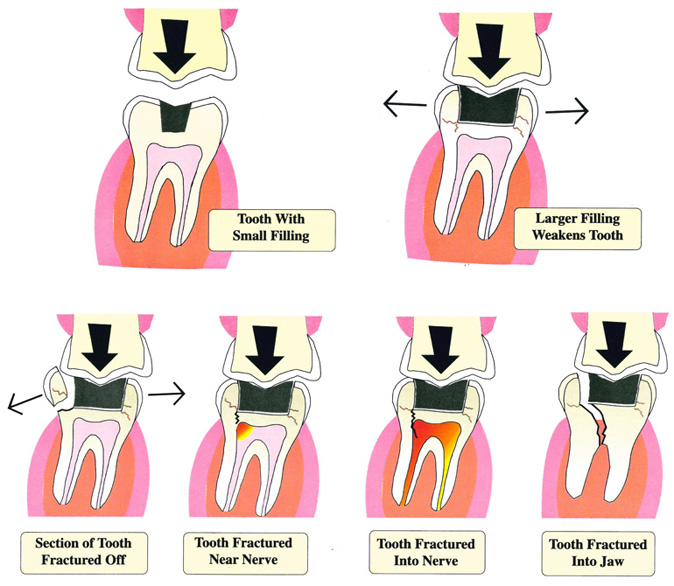Why Our Dental Team Offers Dental Care Without Amalgam
Quite a few patients come to Romie Lane Dental Group wanting to upgrade their silver fillings. They really want their outdated metal fillings taken out and exchanged with tooth-colored fillings. People typically mention esthetic and overall health concerns about their old metal fillings. It is correct that the esthetics of a smile can be drastically improved with a far more natural, tooth colored repair. In addition, there are numerous reasons that would explain why it makes sense to upgrade to a tooth colored porcelain restoration or maybe a resin composite filling.
Almost everything wears out, and your silver fillings will not be any different. They withstand stress-filled and significant biting forces daily, and as they get older, they will crack, leak and may cause damaging fractures in the teeth. Over time, metal amalgam fillings can, in fact, absorb water, causing them to swell and break away from the tooth. When this occurs, your tooth is more susceptible to tooth decay and tenderness.

Mercury/Silver fillings have some other important detractions that should be thought of when it is time for you to replace your restorations:
• Silver fillings are less attractive than natural-colored fillings. Everyone agrees, they scream out, “I am a metal filling put here because this person didn’t take care of their teeth very well!”
• Amalgam grows and contracts when subjected to hot and cold extremes inside your mouth. The constant growth and shrinkage with temperature might set off cracks and fractures in your teeth. There will not be any kind of symptoms for a while, but these teeth can become very sensitive as the fracture increases or opens when you bite down or chew food. It’s not abnormal for patients to come in curious about how they broke their own tooth while they were eating something soft such as a banana or slice of bread. What they don’t know is that the tooth probably had a fracture in it a long time before it ultimately came apart.
• Silver fillings under constant chewing force are prone to metal weakness or bending and flexing failure, a concept which can be fully understood and shown by repeatedly bending a paperclip until it finally breaks.
• Metal fillings are much harder and less flexible than the teeth they’re pressed into. The longer they may be in the teeth, the more force they will put on the rest of the weak surfaces of the tooth bringing about cracks and fractures.
• Metal fillings aren’t glued to the cavity. They only sit in the tooth and react under pressure to split the tooth apart, just like a metal wedge is required to split logs for firewood.
• A microscopic gap around the filling edge exists as soon as the silver filling is plugged into the tooth; and within this gap, continuous leakage and corrosion occurs. This unnoticeable gap is big enough to permit bacteria and food particles to seep in after a while and result in tooth decay at the border between the filling and the tooth. Composite fillings, however, are essentially glued to the tooth surfaces and seal the borders closed from bacterial invasion.
• In order to prepare a tooth for a composite filling, the tooth can usually be treated considerably more gently and with less healthy tooth structure needing to be removed. And thus, the dentist can maintain the highest possible level of original tooth structure as is possible
• Silver fillings require drilling undercuts (think carving out a pumpkin) and taking away larger good parts out of the tooth to be able to keep the mercury amalgam repair from falling out because it is not attached straight to the tooth. These kinds of undercuts might also weaken the tooth as fillings get larger and relegate that tooth to upcoming cracking later on. These cracks can be substantial resulting in crowning the tooth to repair it and even catastrophic cracks bringing about extraction of the tooth.
• Composites, with their opportunity to be conservative and applying their gluelike characteristics, can reinforce and guard against fracture. By simply blocking the potential for fracturing prior to experiencing the signs and symptoms of hot and cold sensitivity and also biting pain, new conservative treatment options such as natural-colored restorations or porcelain-bonded restorations are actually preventing the side effects of toothaches and damaged teeth.
• Finally, many dentists say that, bonded tooth-colored restoratives are probably safer compared to conventional fillings, since they don’t include any mercury. While the American Dental Association (ADA) claims the usage of mercury in metal fillings is harmless, there is certainly an ongoing disagreement in the dental field regarding the side effects of those mercury amalgam fillings. Several of the European countries have prohibited the usage of mercury amalgam fillings to avoid any kind of dangers related to mercury.
Considering the laundry list of negative effects associated, and potentially associated, with silver/mercury amalgam fillings, it’s no wonder that patients are asking Romie Lane Dental Group to be PROACTIVE about removal of mercury fillings instead of being REACTIVE and holding off until the tooth cracks or develops decay under the amalgam plug.
Contact Us
- Romie Lane Dental Group
- Soraya Cameron, DDS
- 770 E. Romie Lane
- Salinas, CA 93901
- (831) 424-3035

